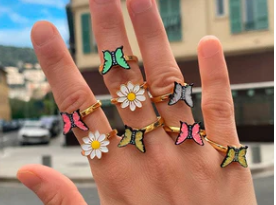Quartz comes in a range of different colors. But the most striking of all is probably rainbow quartz, a glittering stone that reflects every color of the rainbow.
Rainbow quartz goes by a few different names. You may hear it called rainbow aura quartz, mystic quartz, rainbow titanium quartz, rainbow titanium aura quartz, or aurora quartz.
Sometimes it's also called opal aura quartz, angel aura quartz, or flame aura quartz. These are all accurate names for this spectacular stone.
Rainbow quartz has the same overall appearance as natural quartz, but a special coating process is responsible for its brilliant luster.
What is Rainbow Quartz?
The most striking of all varieties of quartz is probably rainbow quartz, a glittering stone that reflects every color of the rainbow. It is made when natural quartz is exposed to heat and metals to give the stone a beautiful, shimmering look.
Rainbow quartz is also called rainbow aura quartz, mystic quartz, rainbow titanium quartz, rainbow titanium aura quartz, or aurora quartz.
Is Rainbow Quartz Natural? Not Completely.
Rainbow quartz doesn't occur completely naturally. It is made when natural quartz is exposed to high heat, gold, and titanium to give the stone an iridescent metallic sheen.
However, it still remains popular among gemstone collectors and jewelry lovers. Some of this may be because it's still a natural stone; it's just been altered through exposure to heat and metals.
How is Rainbow Quartz Made?
Usually, rainbow quartz is made when natural quartz is exposed to high heat, gold, and titanium. This process is called chemical vapor deposition (CVD). First, ordinary quartz is cleaned and placed in a vacuum chamber.
A heat source then evaporates the titanium and gold. The extreme heat turns the coating metals into gas. The metal ions then settle onto the quartz, creating an incredibly thin coating: it usually isn't more than two microns!
Different types of metals result in slightly different "auras," or sheens, on the quartz. Most stones sold as "rainbow quartz" are coated either with titanium alone or with titanium and gold.
If gold is used alone to coat quartz, it usually results in a delicate blue luster. This type of rainbow quartz is usually marketed as "aqua aura quartz."
For more information to click here :- anti anxiety ring
Some manufacturers prefer treating quartz with a mixture of both gold and platinum. This creates a purplish-blue shine, and the resulting stone is typically called "angel aura quartz."
Less commonly, indium may be used to treat quartz. This metal creates a deep blue coloration. Since the finished product looks like tanzanite, the finished product is often called "tanzan aura quartz."
The thin layering of metal on the surface of the quartz causes optical interference. This effect is responsible for the beautiful, shimmering look that rainbow quartz is known for.
Even though rainbow quartz doesn't occur completely naturally, it still remains popular among gemstone collectors and jewelry lovers. Some of this may be because it's still a natural stone; it's just been altered through exposure to heat and metals.





Comments